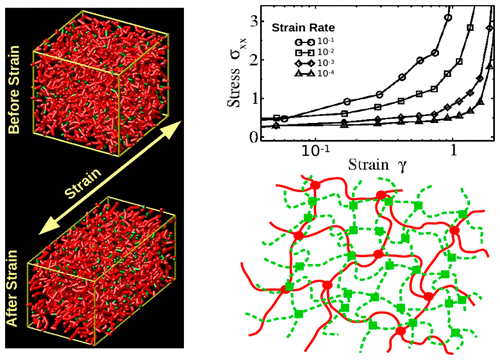当前位置:
X-MOL 学术
›
J. Phys. Chem. Lett.
›
论文详情
Our official English website, www.x-mol.net, welcomes your
feedback! (Note: you will need to create a separate account there.)
Mechanical Strength Management of Polymer Composites through Tuning Transient Networks.
The Journal of Physical Chemistry Letters ( IF 4.8 ) Pub Date : 2020-01-15 , DOI: 10.1021/acs.jpclett.9b03697 Xue-Zheng Cao 1 , Holger Merlitz 2 , Chen-Xu Wu 1
The Journal of Physical Chemistry Letters ( IF 4.8 ) Pub Date : 2020-01-15 , DOI: 10.1021/acs.jpclett.9b03697 Xue-Zheng Cao 1 , Holger Merlitz 2 , Chen-Xu Wu 1
Affiliation

|
The addition of transient networks to polymer composites marks a new direction toward the design of novel materials, with numerous biomedical and industrial applications. The network structure connected by transient cross-links (CLs) relaxes as time evolves, which results in the stretching release of polymer strands between transient CLs during strain. Using molecular dynamics simulations, we measure directly the stress-strain curves of double polymer networks (DPNs), containing both transient and permanent components, at different strain rates. Lifetime and density of transient CLs control the relaxation spectrum of transient networks and determine the mechanical properties of DPNs. A Rouse mode analysis reveals that at high strain rates the mechanical strength of DPNs is defined jointly by the cross-linking structures of permanent and transient networks. At low strain rates, the cross-linking structure of transient network relaxes, leaving the permanent component of the network as a sole contributor to the mechanical strength of DPNs. The transient network is shown to facilitate a dissipation of energy at higher strain rates and prevents a rupture of the network, while the permanent network preserves the structural integrity of the composite at low strain rates. This study provides computational and theoretical foundations for designing polymer composites with desirable mechanical strength and toughness by means of tuning transient networks.
中文翻译:

通过调整瞬态网络来管理聚合物复合材料的机械强度。
在聚合物复合材料中添加瞬态网络标志着新型材料设计的新方向,具有许多生物医学和工业应用。随着时间的流逝,通过瞬态交联(CL)连接的网络结构会松弛,这会导致应变期间瞬态CL之间的聚合物链拉伸释放。使用分子动力学模拟,我们直接测量了双聚合物网络(DPN)的应力-应变曲线,该网络既包含瞬态分量也包含永久分量,并且应变速率不同。瞬态CL的寿命和密度控制瞬态网络的弛豫谱并确定DPN的机械性能。劳斯模式分析表明,在高应变速率下,DPN的机械强度由永久性网络和瞬态网络的交联结构共同定义。在低应变速率下,瞬态网络的交联结构会松弛,从而使网络的永久成分成为DPNs机械强度的唯一贡献者。瞬态网络显示出有助于在较高应变率下耗散能量并防止网络破裂,而永久网络则在低应变率下保持了复合材料的结构完整性。该研究为通过调节瞬态网络设计具有所需机械强度和韧性的聚合物复合材料提供了计算和理论基础。瞬态网络的交联结构松弛了,而网络的永久成分则成为DPNs机械强度的唯一贡献者。瞬态网络显示出有助于在较高应变率下耗散能量并防止网络破裂,而永久网络则在低应变率下保持了复合材料的结构完整性。该研究为通过调节瞬态网络设计具有所需机械强度和韧性的聚合物复合材料提供了计算和理论基础。瞬态网络的交联结构松弛了,而网络的永久成分则成为DPNs机械强度的唯一贡献者。瞬态网络显示出有助于在较高应变率下耗散能量并防止网络破裂,而永久网络则在低应变率下保持了复合材料的结构完整性。该研究为通过调节瞬态网络设计具有所需机械强度和韧性的聚合物复合材料提供了计算和理论基础。永久网络可在低应变率下保持复合材料的结构完整性。该研究为通过调节瞬态网络设计具有所需机械强度和韧性的聚合物复合材料提供了计算和理论基础。永久网络可在低应变率下保持复合材料的结构完整性。该研究为通过调节瞬态网络设计具有所需机械强度和韧性的聚合物复合材料提供了计算和理论基础。
更新日期:2020-01-15
中文翻译:

通过调整瞬态网络来管理聚合物复合材料的机械强度。
在聚合物复合材料中添加瞬态网络标志着新型材料设计的新方向,具有许多生物医学和工业应用。随着时间的流逝,通过瞬态交联(CL)连接的网络结构会松弛,这会导致应变期间瞬态CL之间的聚合物链拉伸释放。使用分子动力学模拟,我们直接测量了双聚合物网络(DPN)的应力-应变曲线,该网络既包含瞬态分量也包含永久分量,并且应变速率不同。瞬态CL的寿命和密度控制瞬态网络的弛豫谱并确定DPN的机械性能。劳斯模式分析表明,在高应变速率下,DPN的机械强度由永久性网络和瞬态网络的交联结构共同定义。在低应变速率下,瞬态网络的交联结构会松弛,从而使网络的永久成分成为DPNs机械强度的唯一贡献者。瞬态网络显示出有助于在较高应变率下耗散能量并防止网络破裂,而永久网络则在低应变率下保持了复合材料的结构完整性。该研究为通过调节瞬态网络设计具有所需机械强度和韧性的聚合物复合材料提供了计算和理论基础。瞬态网络的交联结构松弛了,而网络的永久成分则成为DPNs机械强度的唯一贡献者。瞬态网络显示出有助于在较高应变率下耗散能量并防止网络破裂,而永久网络则在低应变率下保持了复合材料的结构完整性。该研究为通过调节瞬态网络设计具有所需机械强度和韧性的聚合物复合材料提供了计算和理论基础。瞬态网络的交联结构松弛了,而网络的永久成分则成为DPNs机械强度的唯一贡献者。瞬态网络显示出有助于在较高应变率下耗散能量并防止网络破裂,而永久网络则在低应变率下保持了复合材料的结构完整性。该研究为通过调节瞬态网络设计具有所需机械强度和韧性的聚合物复合材料提供了计算和理论基础。永久网络可在低应变率下保持复合材料的结构完整性。该研究为通过调节瞬态网络设计具有所需机械强度和韧性的聚合物复合材料提供了计算和理论基础。永久网络可在低应变率下保持复合材料的结构完整性。该研究为通过调节瞬态网络设计具有所需机械强度和韧性的聚合物复合材料提供了计算和理论基础。











































 京公网安备 11010802027423号
京公网安备 11010802027423号